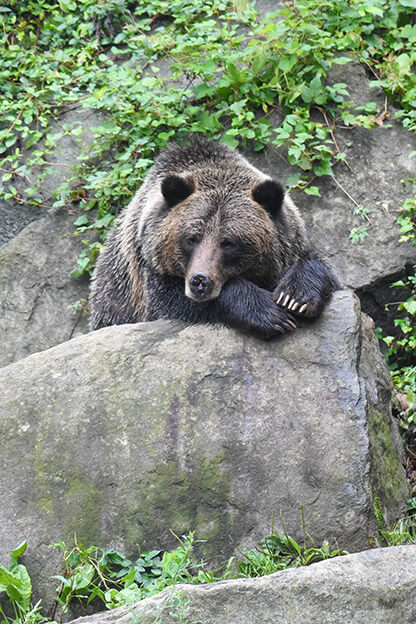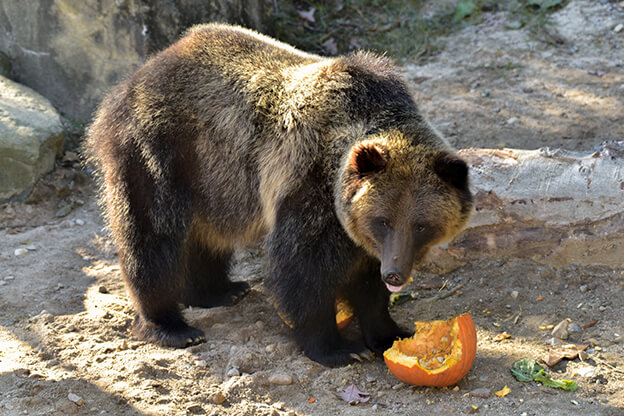Each spring, in a series of fits and starts, Nita and Nova, the Maryland Zoo’s two grizzly bear sisters (Ursus arctos), slowly emerge from their winter torpor as the temperature in the den reflects the warming earth outside.
Our bear team will be monitoring the den on closed-circuit television, just as they have since the pair entered in November. By mid-February the cameras will show each bear groggily stir as hunger and instinct prod them out of the sleeping area and to the mouth of the enclosure where a keeper will be waiting with something to eat.
After having some veggies or chow pellets, these enormous animals plod back to their winter bedding. They’ll repeat the process every so often, moving from bed to food then back again – the ursine equivalent of Netflixing and chilling – until the frequency shortens and, at last, each one is ready to emerge for the season.
Depending on how you look at it, the bear awakening is either the end to, or beginning of, a very complex process for Zoo staff.
A Need for Sleep
Grizzly bears in the wild hibernate to survive the lack of resources during winter. The closer you get to the Arctic Circle, the rougher that season can be. Accordingly, bears grow much larger in size and have deeper seasonal sleep the farther north they live. Greater girth means more insulating fat and calories to keep the body temperature up as the thermometer drops.
In human care, not all bears hibernate. Whether they do is determined by the facility, the local climate, and each animal’s instinct. At the Maryland Zoo that decision is based entirely on our bear’s natural clock. We follow their cues.
“Mid-Atlantic winters aren’t too intense so I was originally surprised to see this behavior from our bears. They just have a drive that makes them want to slow down,” said Curator of Mammals, Erin Grimm.
“If we tried to keep them up it could be a challenging experience for the animals and the staff, like pulling a five month all-nighter.”
The bears make it look easy, but sleeping on the job for months on end involves miraculous metabolic changes.
Unlike small animals that hibernate, a bear’s body temperature doesn’t drop much relative to its large size. But their metabolism and oxygen levels can sink as much as 75 percent. They don’t eat, drink, or defecate and the small amount of urine produced gets broken down and largely reabsorbed. You’d be groggy too if you had to pull out of such a state.
“Because of the biological and physical changes they endure, the bears’ diet going into, and coming out of, hibernation is incredibly important,” Grimm said.

The Quality of Sleep
Bears hibernate. As the summer turns to fall, they begin to store fat to live on during the winter. They look for a nice cave or dig a comfy hole in a protective spot. The shorter the days and the colder the temperature, the sleepier bears get until they eventually head into a den to sleep soundly until spring.
Everyone knows this. It’s a truism we learn at a young age and never question. Maybe it’s time we should.
It turns out, whether bears hibernate when it gets cold is a hotly debated question.
Similar to trees, endothermic vertebrates, such as our bears and badgers, can experience periods of dormancy each winter in response to environmental cues. Their bodies naturally want to shut down.
Many scientists, and even the U.S. Park Service, have referred to bears as “super hibernators.” Other researchers believe that, instead of hibernating, bears enter a state of torpor which also reduces metabolism, heart rate, breathing, and body temperature.
Unlike hibernation, torpor is an involuntary state and the periods of dormancy aren’t quite as deep or long. Think of it as being really groggy and low energy. There’s still a lot of sleeping but you’re also able to move about and perform basic functions.
So which is it, hibernation or torpor?
Hibernation is something of a catch-all term. We prefer “torpor,” which is a state during which normal physical activity is suspended or suppressed.
In torpor, the bears aren’t constantly asleep during the winter. They occasionally get up to shift their bedding or go into the outer chamber of their den. But, while they’re technically awake they’re not in a high functioning state. Even once they’re up for the season, it can take a month or more for energy and appetite to return to normal levels.
Season Cycle
Bears can be mercurial eaters, which keeps the team on its toes. “We’re constantly adapting to find foods that fit their physiological needs and provide enriching social and behavioral benefits, while also keeping an eye on overall nutrition and calorie intake,” Grimm said.
Adding to the challenge, “their diet is very weather dependent,” said Andrew Young who manages the Zoo’s Commissary. “If it stays cooler longer in the spring, they won’t start moving until later. Likewise if it gets cooler earlier in the fall, they slow down sooner.”
In the spring, wild bears forage on leaves and other scrub vegetation near the mouth of the den, gradually venturing farther afield as their strength returns and the growing season gives them more food choices.
We simulate that diet, starting them on fruit and vegetables so that, despite rapacious eating, our enormous animals will actually lose weight as the last of their winter fat burns off.
By June, when kids’ thoughts turn to swimming pools and a long summer break, our team is planning for winter.
At this point, the grizzlies are at their lowest annual weight. For Nita, the smaller of the two, that’s around 315 pounds. Nova will be closer to 425. That may seem pretty heavy but the pair will have to gain significantly more before they bed down for their long winter’s nap.
We’re constantly adapting to find foods that fit their physiological needs and provide enriching social and behavioral benefits, while also keeping an eye on overall nutrition and calorie intake.
Their appetite naturally increases over the summer. By July, we’re providing larger amounts of fruits and vegetables and increasing portions of meat and fish.
When the temperatures are warmest in August and September, the bears will be highly active and very hungry. To keep up with their calorie burn and help them tack on additional weight they’ll receive dense foods in large quantities, like specially-formulated feed pellets, a lot of fatty fish and, of course, honey.
When it comes to weight gain, the clock is ticking. Nita will need to reach 415 pounds and Nova will ultimately weigh in around 600 pounds. To achieve that, the bear’s daily calorie intake will range from a low of just under 2,000 a day in March to more than 16,000 in November.
Since the orphaned sisters arrived here in December 2016, practice has helped our bear team get the dietary timing just right. If the bears don’t achieve ideal weight by the time torpor sets in, they’re more likely to be up feeding over the winter, which can be disruptive.
Once they go into their winter den, it may seem like our staff gets a break. Think again. In addition to monitoring the animals and having food available as needed, the team repairs the outdoor habitat that was dug up or tossed around over the summer.
“Winter is all about putting things back in place so the bears can destroy them again next season,” Grimm said. “Grizzlies, being grizzlies, can be hard on stuff.”
Typical winter work includes re-setting big logs into the slope of the vast outdoor space and creating areas the bears can dig into. This year, the filtration and layout of the pools they swim in will be tweaked and the closed-circuit camera system used by the keepers will be updated.
With the past as guide, Nita and Nova will begin to stir in early March.
“Last year, Nita was fully up and energetic weeks before Nova,” Grimm said. “This is the first year the bears went down for the winter at the same time, so we’re hoping they become active again at the same time.
Human Hibernation?
Scientists are interested in how hibernation could benefit humans. For example, bears become obese but don’t suffer adverse health as a result. How? They can lie mostly dormant for months on end but maintain bone and muscle density. Mimicking these abilities could help with human wellness and aging.
Controlled hypothermia is already used to slow metabolism during human cardiac surgery. Could replicating bear torpor benefit stroke victims by reducing the amount of blood needed in the brain? Or, make deep space flight possible for astronauts?
So many different species experience torpor, including mammals as large as a bear, that scientists are optimistic humans might be able to achieve a similar state. Technological and pharmacological advances are already helping manipulate sleep. But there’s a lot we don’t know about the processes involved. Or, how torpor in humans could affect things like short- and long-term memory.
So many different species experience torpor, including mammals as large as a bear, that scientists are optimistic humans might be able to achieve a similar state.
For something so deceptively simple (animals just go to sleep!) hibernation’s complexities underscore what a feat of nature it really is.
Is it stasis? Renewal? A metaphorical rebirth?
Hibernation is all those things, which makes it worth appreciating as winter gives way to spring. When snowdrop flowers fade and forsythia blooms, bats and badgers and bears and box turtles come back to the waking world.
 BACK TO STORIES
BACK TO STORIES



 MORE ZOOGRAM STORIES
MORE ZOOGRAM STORIES